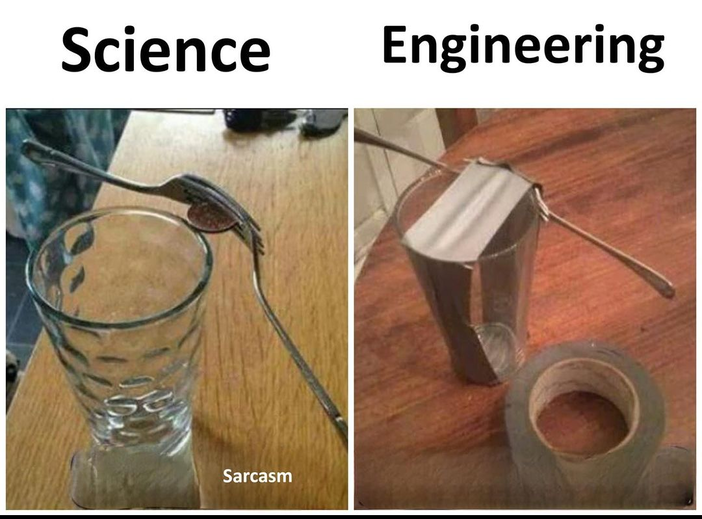Science vs Engineering
I had jobs as a stress analyst at major aerospace companies in the 1980s.
As a stress analyst, I helped ensure that rockets (Commercial Titan) and missiles (Harpoon anti-ship missile)), stayed together in flight and while being transported.
Even though I got a degree in Aerospace Engineering from University of Missouri - Rolla, the difference between “science” and “engineering” was never very clear.

That’s a bit sarcastic, but there’s some truth in it.
Another saying I’ve heard is that
Scientists build things to learn things and engineers learn things to build things.
There’s a lot of truth in that one.
The practicalities of stress analysis, for example, meant believing that you can balance forks on the edge of a glass, but using duct tape, and plenty of it, to ensure the forks stayed there, metaphorically speaking.
An example: unlike in mid-century modern concept drawings, real launch vehicles are cylinders and cones, except for the tip of the payload fairing where aerodynamics actually make an unusual shape worth it. The scientists want the launch vehicle to put as much mass as possible in orbit (they built satellites to learn things), so the engineers like me made the launch vehicles as fragile as possible.
A thin-walled cylinder under axial, compressive loads (rocket engine pushing on the bottom, payload weighing it down at the top) probably fails in a manner called elastic buckling. Based on thickness of the cylinder, stiffness of the material, and radius of the cylinder, buckling loads can vary, and it’s not a simple linear relationship. The radius and thickness of the cylinder’s walls causes the buckled cylinder to have different shapes, 2 lobes, 3 lobes, and so forth. Some of the combinations of radius, thickness and number of lobes would carry a much higher load than others. See figure 4.2 of NASA SP-8007, for example.
Nevertheless, the buckling load we stress analysts read off a graph, the dashed line on figure 4.2 of NASA SP-8007, is well below the expected buckling load. I don’t know why there’s such a taboo on structural failures. Maybe because there’s so many other things that can go wrong when a vehicle flies. Stability, propulsion, guidance are all much bigger issues when flying than for a floating boat, or a rolling car.
